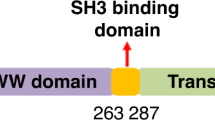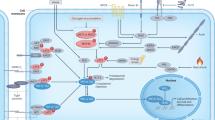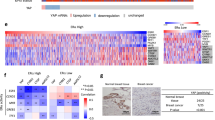Abstract
Yes-associated protein (YAP) has been shown to positively regulate p53 family members and to be negatively regulated by the AKT proto-oncogene product in promoting apoptosis. On the basis of this function and its location at 11q22.2, a site of frequent loss of heterozygosity (LOH) in breast cancer, we investigated whether YAP is a tumor suppressor in breast. Examination of tumors by immunohistochemistry demonstrated significant loss of YAP protein. LOH analysis revealed that protein loss correlates with specific deletion of the YAP gene locus. Functionally, short hairpin RNA knockdown of YAP in breast cell lines suppressed anoikis, increased migration and invasiveness, inhibited the response to taxol and enhanced tumor growth in nude mice. This is the first report indicating YAP as a tumor suppressor, revealing its decreased expression in breast cancer as well as demonstrating the functional implications of YAP loss in several aspects of cancer signaling.
Similar content being viewed by others
Log in or create a free account to read this content
Gain free access to this article, as well as selected content from this journal and more on nature.com
or
Abbreviations
- DCIS:
-
ductal carcinoma in situ
- IF:
-
immunofluorescence
- IHC:
-
immunohistochemistry
- IDC:
-
infiltrating ductal carcinoma
- LOH:
-
loss of heterozygosity
- shRNA:
-
short hairpin RNA
- YAP:
-
Yes-associated protein
References
Antoniou AC, Easton DF . Models of genetic susceptibility to breast cancer. Oncogene 2006; 25: 5898–5905.
Carter SL, Negrini M, Baffa R, Gillum DR, Rosenberg AL, Schwartz GF et al. Loss of heterozygosity at 11q22–q23 in breast cancer. Cancer Res 1994; 54: 6270–6274.
Gudmundsson J, Barkardottir RB, Eiriksdottir G, Baldursson T, Arason A, Egilsson V et al. Loss of heterozygosity at chromosome 11 in breast cancer: association of prognostic factors with genetic alterations. Br J Cancer 1995; 72: 696–701.
Hampton GM, Mannermaa A, Winqvist R, Alavaikko M, Blanco G, Taskinen PJ et al. Loss of heterozygosity in sporadic human breast carcinoma: a common region between 11q22 and 11q23.3. Cancer Res 1994; 54: 4586–4589.
Tomlinson IP, Strickland JE, Lee AS, Bromley L, Evans MF, Morton J et al. Loss of heterozygosity on chromosome 11 q in breast cancer. J Clin Pathol 1995; 48: 424–428.
Winqvist R, Hampton GM, Mannermaa A, Blanco G, Alavaikko M, Kiviniemi H et al. Loss of heterozygosity for chromosome 11 in primary human breast tumors is associated with poor survival after metastasis. Cancer Res 1995; 55: 2660–2664.
Sudol M, Bork P, Einbond A, Kastury K, Druck T, Negrini M et al. Characterization of the mammalian YAP (Yes-associated protein) gene and its role in defining a novel protein module, the WW domain. J Biol Chem 1995; 270: 14733–14741.
Espanel X, Sudol M . Yes-associated protein and p53-binding protein-2 interact through their WW and SH3 domains. J Biol Chem 2001; 276: 14514–14523.
Samuels-Lev Y, O′Connor DJ, Bergamaschi D, Trigiante G, Hsieh JK, Zhong S et al. ASPP proteins specifically stimulate the apoptotic function of p53. Mol Cell 2001; 8: 781–794.
Basu S, Totty NF, Irwin MS, Sudol M, Downward J . Akt phosphorylates the Yes-associated protein, YAP, to induce interaction with 14-3-3 and attenuation of p73-mediated apoptosis. Mol Cell 2003; 11: 11–23.
Hoshino M, Qi ML, Yoshimura N, Miyashita T, Tagawa K, Wada Y et al. Transcriptional repression induces a slowly progressive atypical neuronal death associated with changes of YAP isoforms and p73. J Cell Biol 2006; 172: 589–604.
Matallanas D, Romano D, Yee K, Meissl K, Kucerova L, Piazzolla D et al. RASSF1A elicits apoptosis through an MST2 pathway directing proapoptotic transcription by the p73 tumor suppressor protein. Mol Cell 2007; 27: 962–975.
Strano S, Monti O, Pediconi N, Baccarini A, Fontemaggi G, Lapi E et al. The transcriptional coactivator Yes-associated protein drives p73 gene-target specificity in response to DNA Damage. Mol Cell 2005; 18: 447–459.
Danovi SA, Rossi M, Gudmundsdottir K, Yuan M, Melino G, Basu S . Yes-associated protein (YAP) is a critical mediator of c-Jun-dependent apoptosis. Cell Death Differ 2008; 15: 217–219.
Levy D, Adamovich Y, Reuven N, Shaul Y . The Yes-associated protein 1 stabilizes p73 by preventing Itch-mediated ubiquitination of p73. Cell Death Differ 2007; 14: 743–751.
Bergamaschi A, Kim YH, Wang P, Sorlie T, Hernandez-Boussard T, Lonning PE et al. Distinct patterns of DNA copy number alteration are associated with different clinicopathological features and gene-expression subtypes of breast cancer. Genes Chromosomes Cancer 2006; 45: 1033–1040.
Chin K, DeVries S, Fridlyand J, Spellman PT, Roydasgupta R, Kuo WL et al. Genomic and transcriptional aberrations linked to breast cancer pathophysiologies. Cancer Cell 2006; 10: 529–541.
Douma S, Van Laar T, Zevenhoven J, Meuwissen R, Van Garderen E, Peeper DS . Suppression of anoikis and induction of metastasis by the neurotrophic receptor TrkB. Nature 2004; 430: 1034–1039.
Baldwin C, Garnis C, Zhang L, Rosin MP, Lam WL . Multiple microalterations detected at high frequency in oral cancer. Cancer Res 2005; 65: 7561–7567.
Bashyam MD, Bair R, Kim YH, Wang P, Hernandez-Boussard T, Karikari CA et al. Array-based comparative genomic hybridization identifies localized DNA amplifications and homozygous deletions in pancreatic cancer. Neoplasia 2005; 7: 556–562.
Lambros MB, Fiegler H, Jones A, Gorman P, Roylance RR, Carter NP et al. Analysis of ovarian cancer cell lines using array-based comparative genomic hybridization. J Pathol 2005; 205: 29–40.
Snijders AM, Schmidt BL, Fridlyand J, Dekker N, Pinkel D, Jordan RC et al. Rare amplicons implicate frequent deregulation of cell fate specification pathways in oral squamous cell carcinoma. Oncogene 2005; 24: 4232–4242.
Zender L, Spector MS, Xue W, Flemming P, Cordon-Cardo C, Silke J et al. Identification and validation of oncogenes in liver cancer using an integrative oncogenomic approach. Cell 2006; 125: 1253–1267.
Gorrini C, Squatrito M, Luise C, Syed N, Perna D, Wark L et al. Tip60 is a haplo-insufficient tumour suppressor required for an oncogene-induced DNA damage response. Nature 2007; 448: 1063–1067.
Overholtzer M, Zhang J, Smolen GA, Muir B, Li W, Sgroi DC et al. Transforming properties of YAP, a candidate oncogene on the chromosome 11q22 amplicon. Proc Natl Acad Sci USA 2006; 103: 12405–12410.
Finn RS, Dering J, Ginther C, Wilson CA, Glaspy P, Tchekmedyian N et al. Dasatinib, an orally active small molecule inhibitor of both the src and abl kinases, selectively inhibits growth of basal-type/‘triple-negative’ breast cancer cell lines growing in vitro. Breast Cancer Res Treat 2007; 105: 319–326.
Vitolo MI, Anglin IE, Mahoney Jr WM, Renoud KJ, Gartenhaus RB, Bachman KE et al. The RUNX2 transcription factor cooperates with the YES-associated protein, YAP65, to promote cell transformation. Cancer Biol Ther 2007; 6: 856–863.
Aqeilan RI, Donati V, Gaudio E, Nicoloso MS, Sundvall M, Korhonen A et al. Association of Wwox with ErbB4 in breast cancer. Cancer Res 2007; 67: 9330–9336.
Dong J, Feldmann G, Huang J, Wu S, Zhang N, Comerford SA et al. Elucidation of a universal size-control mechanism in Drosophila and mammals. Cell 2007; 130: 1120–1133.
Komuro A, Nagai M, Navin NE, Sudol M . WW domain-containing protein YAP associates with ErbB-4 and acts as a co-transcriptional activator for the carboxyl-terminal fragment of ErbB-4 that translocates to the nucleus. J Biol Chem 2003; 278: 33334–33341.
Camargo FD, Gokhale S, Johnnidis JB, Fu D, Bell GW, Jaenisch R et al. YAP1 increases organ size and expands undifferentiated progenitor cells. Curr Biol 2007; 17: 2054–2060.
O'Hare MJ, Bond J, Clarke C, Takeuchi Y, Atherton AJ, Berry C et al. Conditional immortalization of freshly isolated human mammary fibroblasts and endothelial cells. Proc Natl Acad Sci USA 2001; 98: 646–651.
Harada T, Baril P, Gangeswaran R, Kelly G, Chelala C, Bhakta V et al. Identification of genetic alterations in pancreatic cancer by the combined use of tissue microdissection and array-based comparative genomic hybridisation. Br J Cancer 2007; 96: 373–382.
Kartasheva NN, Contente A, Lenz-Stoppler C, Roth J, Dobbelstein M . p53 induces the expression of its antagonist p73 Delta N, establishing an autoregulatory feedback loop. Oncogene 2002; 21: 4715–4727.
Acknowledgements
This work was supported by Cancer Research UK and The Research Advisory Board of St. Bartholomew's and The Royal London Charitable Foundation. The authors declare no conflict of interest.
Author information
Authors and Affiliations
Corresponding author
Additional information
Edited by RA Knight
Supplementary Information accompanies the paper on Cell Death and Differentiation website (http://www.nature.com/cdd)
Rights and permissions
About this article
Cite this article
Yuan, M., Tomlinson, V., Lara, R. et al. Yes-associated protein (YAP) functions as a tumor suppressor in breast. Cell Death Differ 15, 1752–1759 (2008). https://doi.org/10.1038/cdd.2008.108
Received:
Revised:
Accepted:
Published:
Issue date:
DOI: https://doi.org/10.1038/cdd.2008.108
Keywords
This article is cited by
-
The impact of tumor microenvironment: unraveling the role of physical cues in breast cancer progression
Cancer and Metastasis Reviews (2024)
-
New insights into the ambivalent role of YAP/TAZ in human cancers
Journal of Experimental & Clinical Cancer Research (2023)
-
Anoikis resistance––protagonists of breast cancer cells survive and metastasize after ECM detachment
Cell Communication and Signaling (2023)
-
Biophysics in tumor growth and progression: from single mechano-sensitive molecules to mechanomedicine
Oncogene (2023)
-
YAP transduction drives triple-negative breast cancer aggressiveness through modulating the EGFR‒AKT axis in patient-derived xenograft cells
Medical Oncology (2023)



